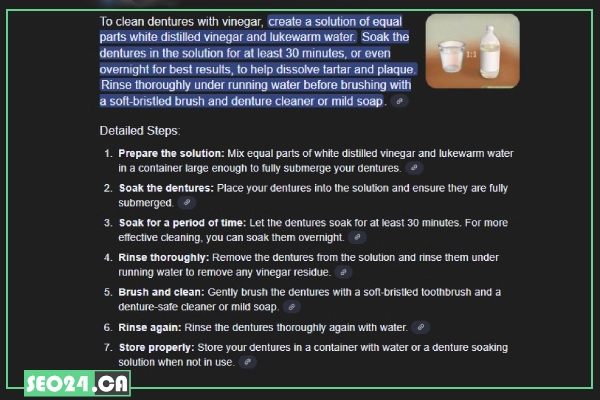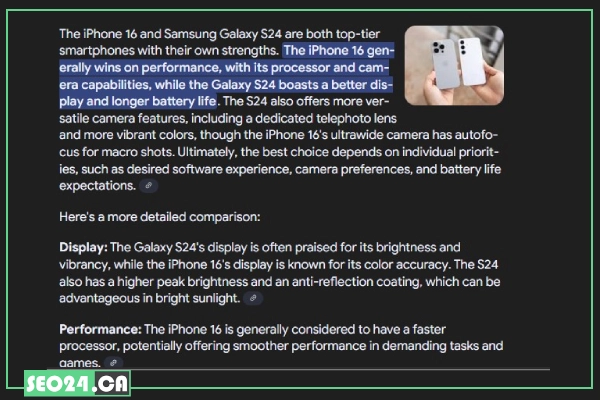
How to use Google AI Overview
AI overviews are reshaping how information is presented and consumed online. Understanding how to create and optimize content for these AI-generated summaries is essential for boosting your SEO and standing out in search results. This guide will walk you through the key strategies to harness the power of AI overviews and improve your site’s visibility effectively.
Table of Contents
What Exactly Are AI Overviews?
AI overviews refer to concise summaries or high-level explanations generated by artificial intelligence systems that capture the essential aspects of a topic, document, or dataset. These overviews help users quickly grasp complex information without needing to read through lengthy content. They can vary in scope and detail depending on the purpose, ranging from brief abstracts to comprehensive executive summaries. In the following sections, we will explore the different types of AI overviews and how they are used across various applications.
AI Overview Examples
AI overviews come in various forms tailored to different user needs and content types. Below are common examples of how AI summarizes and presents information to enhance user experience across multiple applications.
✅ Informational Queries: AI provides concise answers or summaries to user questions, delivering clear and accurate information quickly.
Example: A brief explanation of how photosynthesis works when asked on a search engine.

✅ Step-by-Step Guides: AI generates detailed, ordered instructions to help users complete tasks or understand processes efficiently.
Example: A step-by-step guide on cleaning dentures with vinegar .

✅ Product Comparisons: AI summarizes key features, pros, and cons of multiple products to assist users in making informed purchasing decisions.
Example: Comparing smartphones by battery life, camera quality, and price.

✅ Tables with Images: AI creates structured tables paired with relevant images to visually organize data for easier comprehension.
Example: A table listing laptop models with images, specs, and prices side by side.
✅ Shopping-Focused Results: AI highlights product availability, deals, and reviews to streamline online shopping experiences.
Example: Showing top-rated headphones with prices and discount offers.
✅ Quick Access Links: AI provides direct links to related content or tools, enabling faster navigation to relevant resources.
Example: Links to official user manuals, FAQ pages, or customer support for a software product.
Why Are AI Overviews Important for SEO?
AI overviews play a crucial role in modern SEO by enhancing how content is presented and consumed on search engines. These concise, AI-generated summaries help users quickly understand complex topics, which leads to improved user satisfaction and engagement. Here’s why AI overviews are increasingly important for SEO success:
- Improved User Experience: AI overviews deliver precise information fast, reducing the time users spend searching for answers. This positive experience encourages longer site visits and lowers bounce rates, signaling to search engines that your content is valuable.
- Higher Search Visibility: Well-crafted AI overviews are often featured in rich snippets, knowledge panels, and other enhanced search results. These placements boost your site’s prominence on the results page and increase the chances of attracting clicks.
- Better Matching of User Intent: AI overviews can be tailored to answer specific queries or provide relevant summaries that align closely with what users are looking for, improving content relevance and search rankings.
- Competitive Advantage: As AI-generated content becomes more common, utilizing AI overviews ensures your site stays ahead by adapting to evolving search algorithms and user expectations.
Incorporating AI overview SEO techniques into your content strategy is essential for maintaining visibility and engagement in today’s AI-driven digital landscape.
How Do AI Overviews Work?
AI overviews are created using advanced natural language processing (NLP) and machine learning algorithms that analyze large amounts of text to identify key points, patterns, and relevant information. By understanding the context and intent behind the content, AI models generate concise summaries or structured representations that capture the most important aspects without losing meaning. These overviews can be customized based on the target audience or platform, enabling faster comprehension and improved user experience across websites, search engines, and applications.
How to Optimize Your Content for AI Overviews?
Optimizing your content for AI overviews involves tailoring it to be clear, structured, and easily understandable by AI algorithms that generate these summaries. By following best practices, you can increase the chances that your content will be featured in AI-generated snippets and enhance your overall SEO performance. In the following sections, we’ll cover practical strategies and tips on how to optimize for AI overviews effectively.
Understand User Intent
To optimize for AI overviews, it’s essential to fully understand the intent behind users’ search queries. AI systems are designed to match content that best answers a user’s specific question or need. By researching common queries and providing clear, targeted responses, you increase the likelihood that your content will be selected for AI-generated summaries. Aligning your content with user intent helps search engines recognize its relevance, improving your chances of appearing in featured snippets and overview results.
Focus on High-Quality, Authoritative Content for Users
AI overviews prioritize trustworthy and well-researched information. Producing high-quality, authoritative content that provides real value to readers is key to standing out. This means backing up claims with credible sources, avoiding fluff or filler, and addressing topics comprehensively. Search engines reward content that establishes expertise and trustworthiness, which in turn makes it more likely to be chosen for AI summaries that users rely on for quick, accurate insights.
Create a Good User Experience (UX)
A positive user experience encourages visitors to engage with your content longer and signals to search engines that your page is valuable. Clear navigation, fast loading times, mobile-friendly design, and easy-to-read formatting all contribute to good UX. When AI algorithms evaluate content for overviews, they consider not only relevance but also how accessible and user-friendly it is. Ensuring your site delivers a seamless experience can boost your chances of featuring in AI-driven results.
Structure Your Content for Clarity and Scannability
Organizing your content in a clear and easy-to-scan format helps both users and AI systems quickly find and understand key information. Here are some essential techniques to structure your content effectively:
- Clear Headings and Subheadings: Use descriptive and hierarchical headings to organize content, making it easy for AI and readers to follow the structure.
- Concise Paragraphs: Keep paragraphs short and focused on one main idea to improve readability and help AI extract key points efficiently.
- Bullet Points and Numbered Lists: Highlight important information and steps using lists, which enhance clarity and allow quick scanning.
- Table of Contents: Provide a clickable overview of your content sections to help users navigate and for AI to understand the content hierarchy better.
Optimize for Different Content Formats
Different content formats require tailored optimization to ensure AI overviews capture the most relevant information effectively. Understanding how to structure each format improves clarity and user engagement:
- Definitions: Provide clear, concise definitions that directly explain terms or concepts.
- Step-by-Step Guides: Use numbered lists to break down processes into easy-to-follow steps.
- Comparisons: Present information using tables or pros and cons lists to highlight differences clearly.
- Summaries: Include a concise summary at the beginning or end of content to encapsulate key points for quick understanding.
Optimize for Multimodal Search
With the rise of multimodal search—where users search using a combination of text, images, and sometimes voice—optimizing content to cater to multiple input types is essential. This means incorporating relevant visuals, descriptive alt text for images, and clear, context-rich text that complements media elements. By doing so, AI systems can better understand and summarize your content across formats, increasing your chances of appearing in diverse search results and AI overviews that blend text and visuals.
Answer Specific Questions Directly and Concisely
Answering specific user questions clearly and briefly helps AI overviews identify and feature your content as a reliable source. Follow these steps to optimize your answers:
- Identify Common Questions: Research and gather the most frequent queries your audience has about your topic.
- Direct Answers: Provide straightforward, focused responses without unnecessary details or jargon.
- “What is X?” “How to Y?” “Why does Z?” Format: Structure your content using familiar question formats that align with how users phrase their searches and how AI models parse content.
Match Structured Data to Your Content
Using structured data helps search engines better understand the context and details of your content, which can improve how AI overviews interpret and display your information. By implementing the appropriate schema markup that accurately reflects your content type such as articles, products, FAQs, or events you provide clear signals to AI systems. This alignment increases the likelihood of your content being featured prominently in search results and AI-generated summaries.
Technical SEO Considerations
Ensuring your website meets technical SEO standards is essential for AI overviews to access and evaluate your content effectively. Key technical factors include:
- Googlebot isn’t blocked: Make sure your site’s robots.txt or meta tags do not prevent Googlebot from crawling important pages.
- Page returns HTTP 200 (success) status: Pages must load correctly with a successful HTTP response to be indexed and summarized.
- Content is indexable: Avoid using noindex tags on pages you want included in AI overviews and search results.
- Mobile-Friendliness: A responsive design improves user experience and search rankings, which affects AI content selection.
- Page Speed: Fast-loading pages are favored by search engines and reduce user bounce rates, increasing the chance of content being used in AI overviews.
Monitor and Adapt
Regularly tracking how your content performs in search results and AI-generated overviews allows you to make informed adjustments. Use analytics and SEO tools to monitor rankings, user engagement, and the appearance of AI snippets. Based on this data, refine your content, update outdated information, and adapt to changes in search algorithms and AI technology to maintain and improve your visibility over time.
💡High-quality content is the foundation of effective AI overviews and strong SEO performance. Our experienced team at content writing services Toronto crafts well-researched, engaging, and optimized content that addresses user intent and minimizes issues like duplicate content helping your site rank higher and attract the right audience.
Control AI Overviews with Preview Controls
Managing how AI-generated overviews display your content is essential to maintain control over your site’s presence in search results. Several meta tags and directives allow you to influence or restrict snippet generation:
- Nosnippet: Prevents search engines from showing any text snippet from the page in search results, limiting content exposure in AI overviews.
- Data-nosnippet: Blocks specific parts of a page from being included in snippets, allowing selective control over what is shown.
- Max-snippet: Limits the length of the text snippet search engines can display, helping to keep previews concise.
- Noindex: Instructs search engines not to index the page at all, removing it from search results and AI-generated summaries.
Using these controls strategically helps you manage how your content appears and ensures AI overviews reflect your desired presentation.
💡A specialized SEO team knows exactly how to tackle challenges related to AI overviews and optimize your content for maximum visibility. For expert support, trust the SEO service in Toronto that delivers effective, tailored strategies to keep your site ahead in search rankings.
Conclusion
AI overviews are transforming how users find and digest information online. By understanding their importance and optimizing your content accordingly, you can improve search visibility, user engagement, and overall SEO performance. Staying ahead in this evolving landscape requires a strategic approach to content structure, technical SEO, and continuous adaptation.
For expert guidance and professional SEO services, don’t hesitate to reach out to our trusted SEO agency North York. Our team is here to help you improve your website’s performance and achieve the best results online.
FAQ
How to write for AI Overview?
Focus on clear, concise, and well-structured content that directly answers common user questions. Use headings, bullet points, and simple language to make information easy to digest.
How to optimize AI overview?
Align content with user intent, use authoritative sources, implement proper technical SEO, and structure content for scannability to improve chances of being featured in AI summaries.
Related Posts
Learn what SEO is and why it's crucial for your business. Find out how optimizing your website can boost…
by
Having a great website is just the first step. To get people to visit it, they need to be…
by
As voice search becomes more popular, it's clear that people are changing how they look for information online. Users…
by
With the rise of zero-click searches, ranking at the top of Google's search results has taken on a new…
by


